Effective Talent Management in Brightstar Financial: A Research Report
VerifiedAdded on 2021/07/09
|25
|4302
|139
Report
AI Summary
This report provides a comprehensive analysis of talent management practices within Brightstar Financial, a UK-based financial distribution company. The study investigates the company's HR strategies, focusing on talent acquisition, employee development, training, and compensation & recognition programs. The research employs a mixed-methods approach, including a literature review, qualitative and quantitative data collection through questionnaires, and analysis of both primary and secondary data. The report aims to identify effective HR strategies and offer recommendations for enhancing talent management within Brightstar Financial. Key areas of focus include career advancement, technology integration, training initiatives, and employee motivation. The research also addresses the limitations of the study and proposes alternative research methodologies.
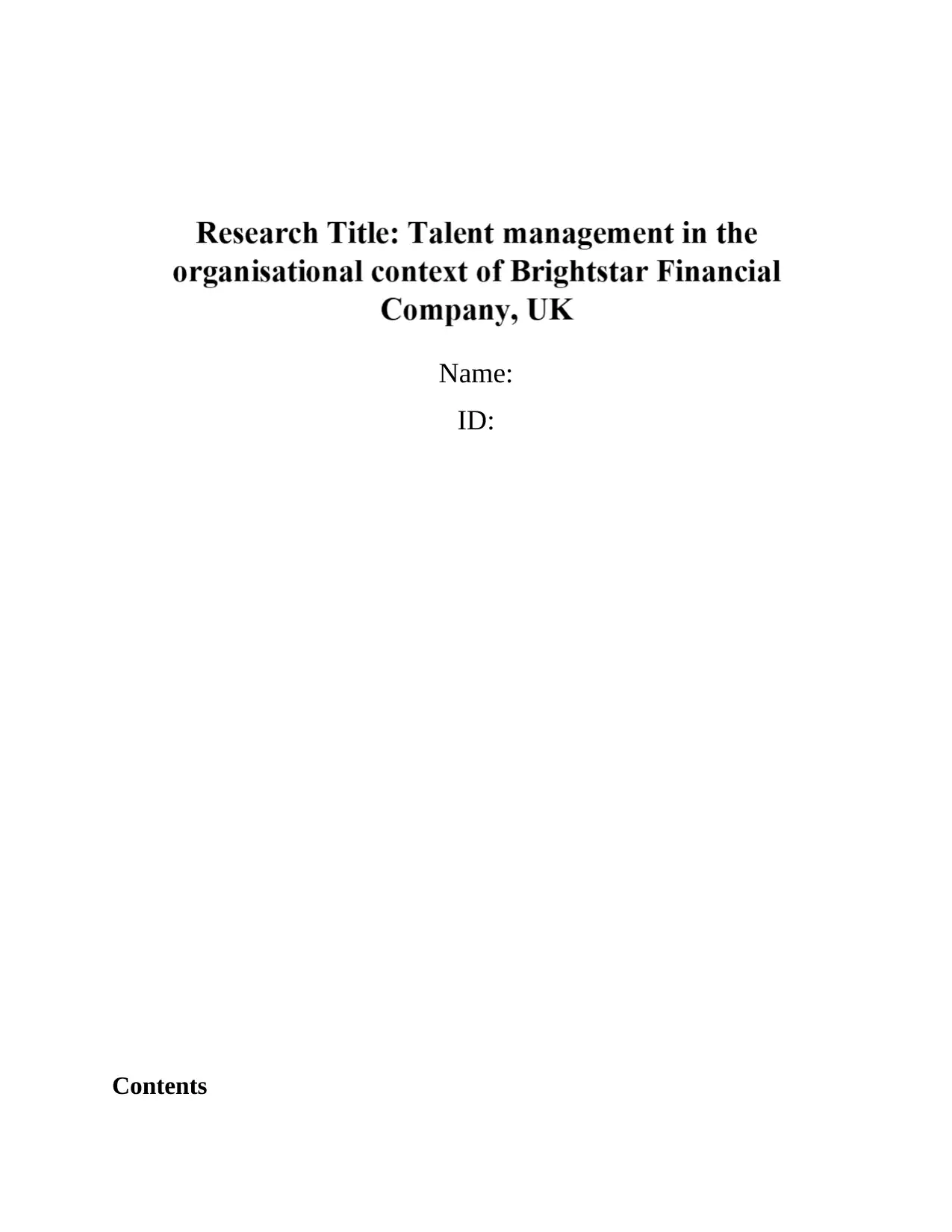
Name:
ID:
Contents
ID:
Contents
Paraphrase This Document
Need a fresh take? Get an instant paraphrase of this document with our AI Paraphraser
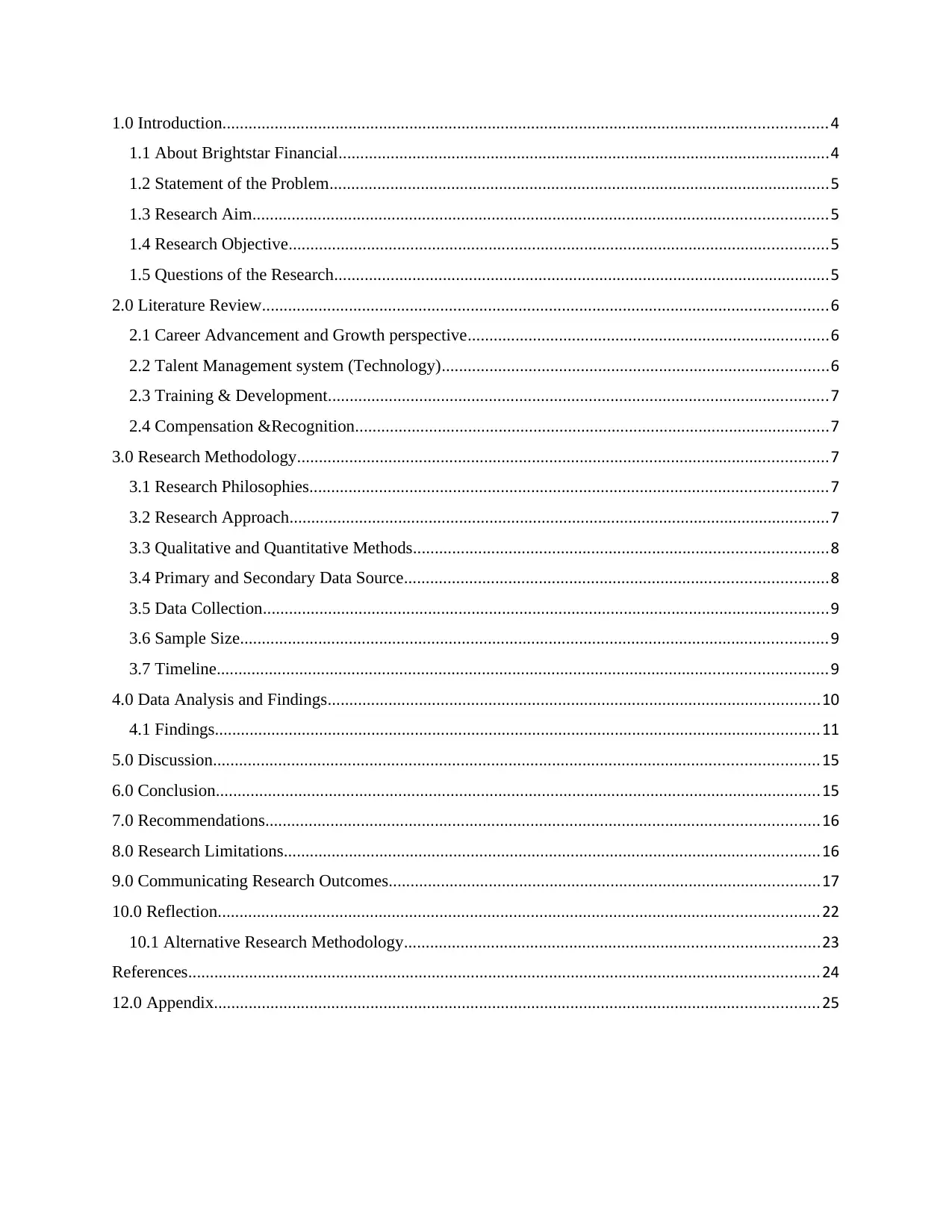
1.0 Introduction...........................................................................................................................................4
1.1 About Brightstar Financial.................................................................................................................4
1.2 Statement of the Problem...................................................................................................................5
1.3 Research Aim....................................................................................................................................5
1.4 Research Objective............................................................................................................................5
1.5 Questions of the Research..................................................................................................................5
2.0 Literature Review..................................................................................................................................6
2.1 Career Advancement and Growth perspective...................................................................................6
2.2 Talent Management system (Technology).........................................................................................6
2.3 Training & Development...................................................................................................................7
2.4 Compensation &Recognition.............................................................................................................7
3.0 Research Methodology..........................................................................................................................7
3.1 Research Philosophies.......................................................................................................................7
3.2 Research Approach............................................................................................................................7
3.3 Qualitative and Quantitative Methods...............................................................................................8
3.4 Primary and Secondary Data Source.................................................................................................8
3.5 Data Collection..................................................................................................................................9
3.6 Sample Size.......................................................................................................................................9
3.7 Timeline............................................................................................................................................9
4.0 Data Analysis and Findings.................................................................................................................10
4.1 Findings...........................................................................................................................................11
5.0 Discussion...........................................................................................................................................15
6.0 Conclusion...........................................................................................................................................15
7.0 Recommendations...............................................................................................................................16
8.0 Research Limitations...........................................................................................................................16
9.0 Communicating Research Outcomes...................................................................................................17
10.0 Reflection..........................................................................................................................................22
10.1 Alternative Research Methodology...............................................................................................23
References.................................................................................................................................................24
12.0 Appendix...........................................................................................................................................25
1.1 About Brightstar Financial.................................................................................................................4
1.2 Statement of the Problem...................................................................................................................5
1.3 Research Aim....................................................................................................................................5
1.4 Research Objective............................................................................................................................5
1.5 Questions of the Research..................................................................................................................5
2.0 Literature Review..................................................................................................................................6
2.1 Career Advancement and Growth perspective...................................................................................6
2.2 Talent Management system (Technology).........................................................................................6
2.3 Training & Development...................................................................................................................7
2.4 Compensation &Recognition.............................................................................................................7
3.0 Research Methodology..........................................................................................................................7
3.1 Research Philosophies.......................................................................................................................7
3.2 Research Approach............................................................................................................................7
3.3 Qualitative and Quantitative Methods...............................................................................................8
3.4 Primary and Secondary Data Source.................................................................................................8
3.5 Data Collection..................................................................................................................................9
3.6 Sample Size.......................................................................................................................................9
3.7 Timeline............................................................................................................................................9
4.0 Data Analysis and Findings.................................................................................................................10
4.1 Findings...........................................................................................................................................11
5.0 Discussion...........................................................................................................................................15
6.0 Conclusion...........................................................................................................................................15
7.0 Recommendations...............................................................................................................................16
8.0 Research Limitations...........................................................................................................................16
9.0 Communicating Research Outcomes...................................................................................................17
10.0 Reflection..........................................................................................................................................22
10.1 Alternative Research Methodology...............................................................................................23
References.................................................................................................................................................24
12.0 Appendix...........................................................................................................................................25
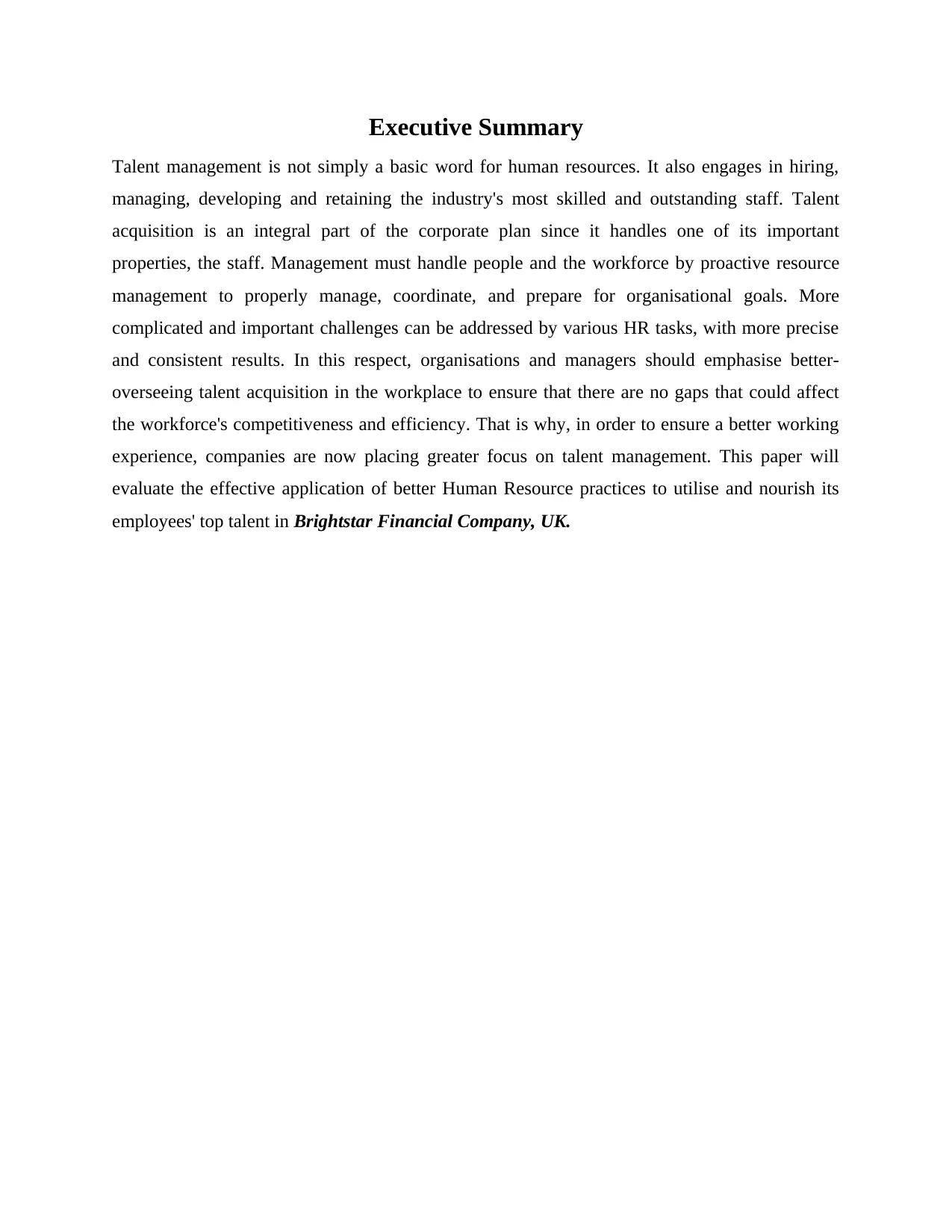
Executive Summary
Talent management is not simply a basic word for human resources. It also engages in hiring,
managing, developing and retaining the industry's most skilled and outstanding staff. Talent
acquisition is an integral part of the corporate plan since it handles one of its important
properties, the staff. Management must handle people and the workforce by proactive resource
management to properly manage, coordinate, and prepare for organisational goals. More
complicated and important challenges can be addressed by various HR tasks, with more precise
and consistent results. In this respect, organisations and managers should emphasise better-
overseeing talent acquisition in the workplace to ensure that there are no gaps that could affect
the workforce's competitiveness and efficiency. That is why, in order to ensure a better working
experience, companies are now placing greater focus on talent management. This paper will
evaluate the effective application of better Human Resource practices to utilise and nourish its
employees' top talent in Brightstar Financial Company, UK.
Talent management is not simply a basic word for human resources. It also engages in hiring,
managing, developing and retaining the industry's most skilled and outstanding staff. Talent
acquisition is an integral part of the corporate plan since it handles one of its important
properties, the staff. Management must handle people and the workforce by proactive resource
management to properly manage, coordinate, and prepare for organisational goals. More
complicated and important challenges can be addressed by various HR tasks, with more precise
and consistent results. In this respect, organisations and managers should emphasise better-
overseeing talent acquisition in the workplace to ensure that there are no gaps that could affect
the workforce's competitiveness and efficiency. That is why, in order to ensure a better working
experience, companies are now placing greater focus on talent management. This paper will
evaluate the effective application of better Human Resource practices to utilise and nourish its
employees' top talent in Brightstar Financial Company, UK.
⊘ This is a preview!⊘
Do you want full access?
Subscribe today to unlock all pages.

Trusted by 1+ million students worldwide
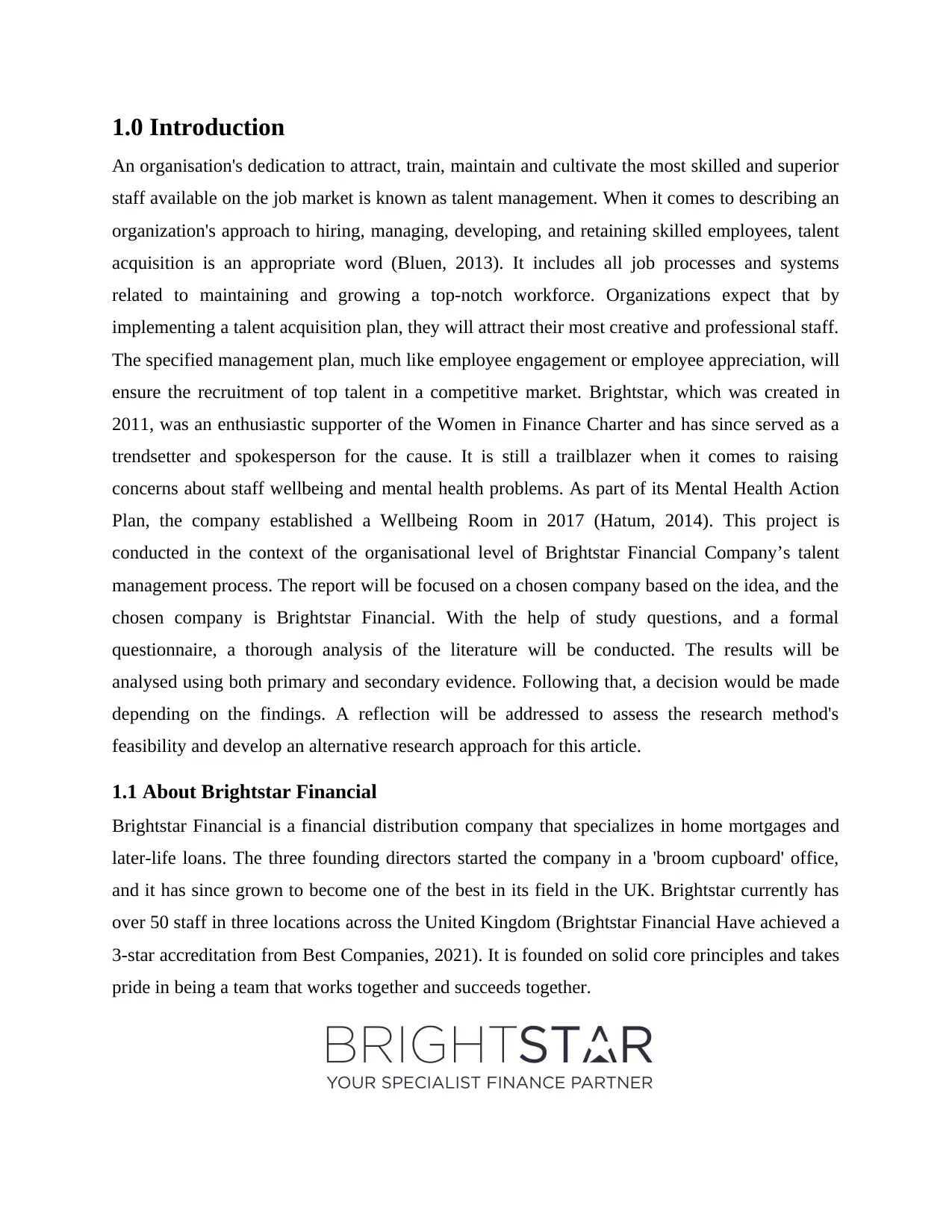
1.0 Introduction
An organisation's dedication to attract, train, maintain and cultivate the most skilled and superior
staff available on the job market is known as talent management. When it comes to describing an
organization's approach to hiring, managing, developing, and retaining skilled employees, talent
acquisition is an appropriate word (Bluen, 2013). It includes all job processes and systems
related to maintaining and growing a top-notch workforce. Organizations expect that by
implementing a talent acquisition plan, they will attract their most creative and professional staff.
The specified management plan, much like employee engagement or employee appreciation, will
ensure the recruitment of top talent in a competitive market. Brightstar, which was created in
2011, was an enthusiastic supporter of the Women in Finance Charter and has since served as a
trendsetter and spokesperson for the cause. It is still a trailblazer when it comes to raising
concerns about staff wellbeing and mental health problems. As part of its Mental Health Action
Plan, the company established a Wellbeing Room in 2017 (Hatum, 2014). This project is
conducted in the context of the organisational level of Brightstar Financial Company’s talent
management process. The report will be focused on a chosen company based on the idea, and the
chosen company is Brightstar Financial. With the help of study questions, and a formal
questionnaire, a thorough analysis of the literature will be conducted. The results will be
analysed using both primary and secondary evidence. Following that, a decision would be made
depending on the findings. A reflection will be addressed to assess the research method's
feasibility and develop an alternative research approach for this article.
1.1 About Brightstar Financial
Brightstar Financial is a financial distribution company that specializes in home mortgages and
later-life loans. The three founding directors started the company in a 'broom cupboard' office,
and it has since grown to become one of the best in its field in the UK. Brightstar currently has
over 50 staff in three locations across the United Kingdom (Brightstar Financial Have achieved a
3-star accreditation from Best Companies, 2021). It is founded on solid core principles and takes
pride in being a team that works together and succeeds together.
An organisation's dedication to attract, train, maintain and cultivate the most skilled and superior
staff available on the job market is known as talent management. When it comes to describing an
organization's approach to hiring, managing, developing, and retaining skilled employees, talent
acquisition is an appropriate word (Bluen, 2013). It includes all job processes and systems
related to maintaining and growing a top-notch workforce. Organizations expect that by
implementing a talent acquisition plan, they will attract their most creative and professional staff.
The specified management plan, much like employee engagement or employee appreciation, will
ensure the recruitment of top talent in a competitive market. Brightstar, which was created in
2011, was an enthusiastic supporter of the Women in Finance Charter and has since served as a
trendsetter and spokesperson for the cause. It is still a trailblazer when it comes to raising
concerns about staff wellbeing and mental health problems. As part of its Mental Health Action
Plan, the company established a Wellbeing Room in 2017 (Hatum, 2014). This project is
conducted in the context of the organisational level of Brightstar Financial Company’s talent
management process. The report will be focused on a chosen company based on the idea, and the
chosen company is Brightstar Financial. With the help of study questions, and a formal
questionnaire, a thorough analysis of the literature will be conducted. The results will be
analysed using both primary and secondary evidence. Following that, a decision would be made
depending on the findings. A reflection will be addressed to assess the research method's
feasibility and develop an alternative research approach for this article.
1.1 About Brightstar Financial
Brightstar Financial is a financial distribution company that specializes in home mortgages and
later-life loans. The three founding directors started the company in a 'broom cupboard' office,
and it has since grown to become one of the best in its field in the UK. Brightstar currently has
over 50 staff in three locations across the United Kingdom (Brightstar Financial Have achieved a
3-star accreditation from Best Companies, 2021). It is founded on solid core principles and takes
pride in being a team that works together and succeeds together.
Paraphrase This Document
Need a fresh take? Get an instant paraphrase of this document with our AI Paraphraser
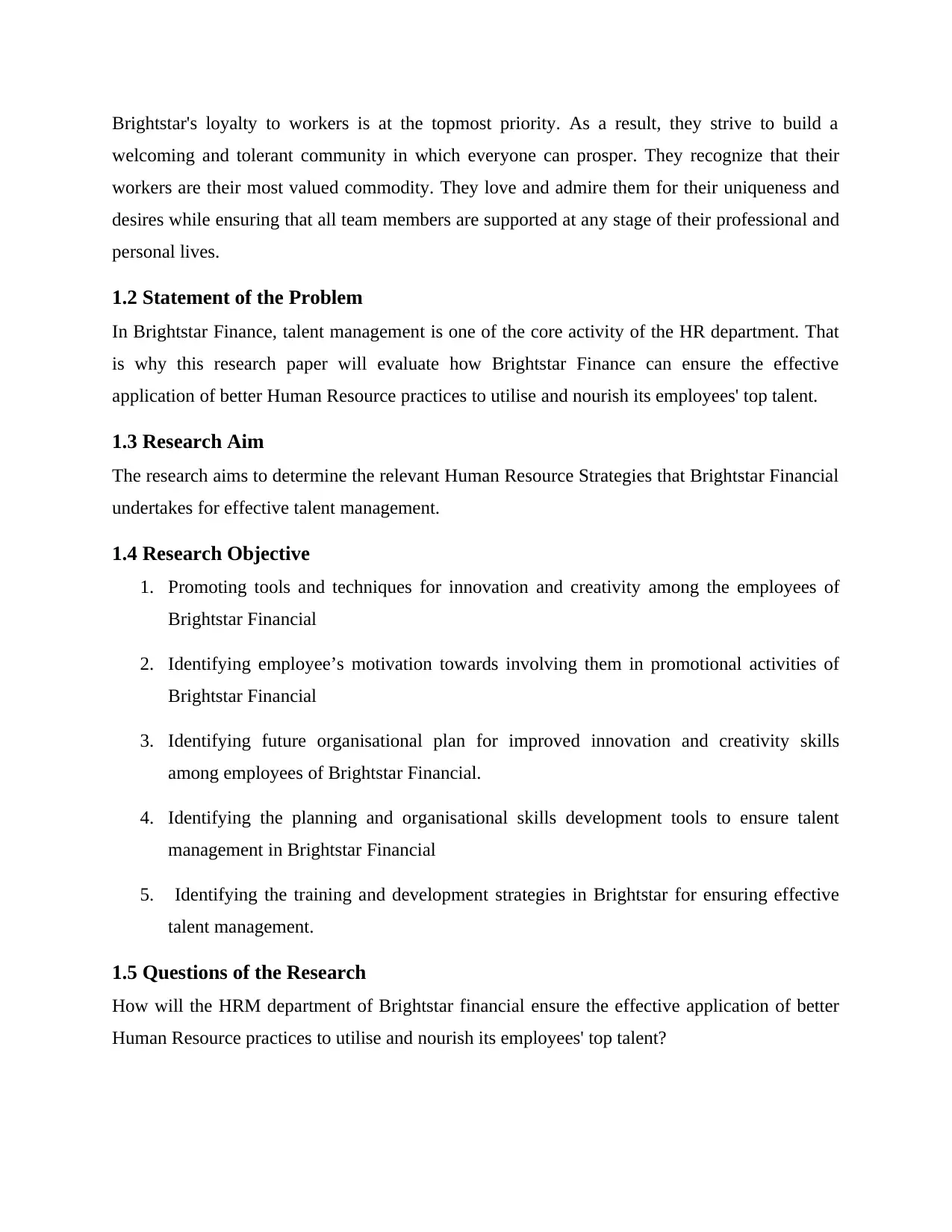
Brightstar's loyalty to workers is at the topmost priority. As a result, they strive to build a
welcoming and tolerant community in which everyone can prosper. They recognize that their
workers are their most valued commodity. They love and admire them for their uniqueness and
desires while ensuring that all team members are supported at any stage of their professional and
personal lives.
1.2 Statement of the Problem
In Brightstar Finance, talent management is one of the core activity of the HR department. That
is why this research paper will evaluate how Brightstar Finance can ensure the effective
application of better Human Resource practices to utilise and nourish its employees' top talent.
1.3 Research Aim
The research aims to determine the relevant Human Resource Strategies that Brightstar Financial
undertakes for effective talent management.
1.4 Research Objective
1. Promoting tools and techniques for innovation and creativity among the employees of
Brightstar Financial
2. Identifying employee’s motivation towards involving them in promotional activities of
Brightstar Financial
3. Identifying future organisational plan for improved innovation and creativity skills
among employees of Brightstar Financial.
4. Identifying the planning and organisational skills development tools to ensure talent
management in Brightstar Financial
5. Identifying the training and development strategies in Brightstar for ensuring effective
talent management.
1.5 Questions of the Research
How will the HRM department of Brightstar financial ensure the effective application of better
Human Resource practices to utilise and nourish its employees' top talent?
welcoming and tolerant community in which everyone can prosper. They recognize that their
workers are their most valued commodity. They love and admire them for their uniqueness and
desires while ensuring that all team members are supported at any stage of their professional and
personal lives.
1.2 Statement of the Problem
In Brightstar Finance, talent management is one of the core activity of the HR department. That
is why this research paper will evaluate how Brightstar Finance can ensure the effective
application of better Human Resource practices to utilise and nourish its employees' top talent.
1.3 Research Aim
The research aims to determine the relevant Human Resource Strategies that Brightstar Financial
undertakes for effective talent management.
1.4 Research Objective
1. Promoting tools and techniques for innovation and creativity among the employees of
Brightstar Financial
2. Identifying employee’s motivation towards involving them in promotional activities of
Brightstar Financial
3. Identifying future organisational plan for improved innovation and creativity skills
among employees of Brightstar Financial.
4. Identifying the planning and organisational skills development tools to ensure talent
management in Brightstar Financial
5. Identifying the training and development strategies in Brightstar for ensuring effective
talent management.
1.5 Questions of the Research
How will the HRM department of Brightstar financial ensure the effective application of better
Human Resource practices to utilise and nourish its employees' top talent?
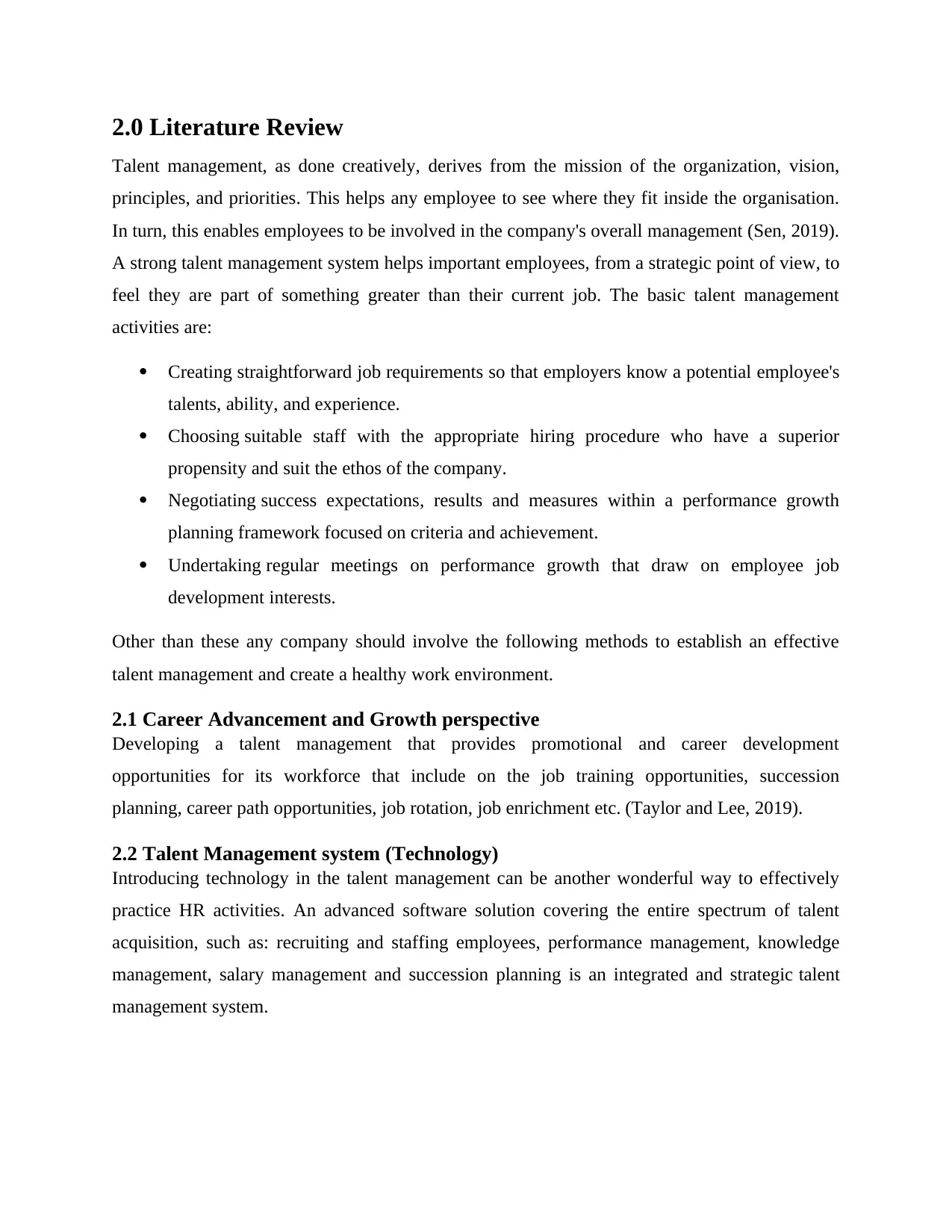
2.0 Literature Review
Talent management, as done creatively, derives from the mission of the organization, vision,
principles, and priorities. This helps any employee to see where they fit inside the organisation.
In turn, this enables employees to be involved in the company's overall management (Sen, 2019).
A strong talent management system helps important employees, from a strategic point of view, to
feel they are part of something greater than their current job. The basic talent management
activities are:
Creating straightforward job requirements so that employers know a potential employee's
talents, ability, and experience.
Choosing suitable staff with the appropriate hiring procedure who have a superior
propensity and suit the ethos of the company.
Negotiating success expectations, results and measures within a performance growth
planning framework focused on criteria and achievement.
Undertaking regular meetings on performance growth that draw on employee job
development interests.
Other than these any company should involve the following methods to establish an effective
talent management and create a healthy work environment.
2.1 Career Advancement and Growth perspective
Developing a talent management that provides promotional and career development
opportunities for its workforce that include on the job training opportunities, succession
planning, career path opportunities, job rotation, job enrichment etc. (Taylor and Lee, 2019).
2.2 Talent Management system (Technology)
Introducing technology in the talent management can be another wonderful way to effectively
practice HR activities. An advanced software solution covering the entire spectrum of talent
acquisition, such as: recruiting and staffing employees, performance management, knowledge
management, salary management and succession planning is an integrated and strategic talent
management system.
Talent management, as done creatively, derives from the mission of the organization, vision,
principles, and priorities. This helps any employee to see where they fit inside the organisation.
In turn, this enables employees to be involved in the company's overall management (Sen, 2019).
A strong talent management system helps important employees, from a strategic point of view, to
feel they are part of something greater than their current job. The basic talent management
activities are:
Creating straightforward job requirements so that employers know a potential employee's
talents, ability, and experience.
Choosing suitable staff with the appropriate hiring procedure who have a superior
propensity and suit the ethos of the company.
Negotiating success expectations, results and measures within a performance growth
planning framework focused on criteria and achievement.
Undertaking regular meetings on performance growth that draw on employee job
development interests.
Other than these any company should involve the following methods to establish an effective
talent management and create a healthy work environment.
2.1 Career Advancement and Growth perspective
Developing a talent management that provides promotional and career development
opportunities for its workforce that include on the job training opportunities, succession
planning, career path opportunities, job rotation, job enrichment etc. (Taylor and Lee, 2019).
2.2 Talent Management system (Technology)
Introducing technology in the talent management can be another wonderful way to effectively
practice HR activities. An advanced software solution covering the entire spectrum of talent
acquisition, such as: recruiting and staffing employees, performance management, knowledge
management, salary management and succession planning is an integrated and strategic talent
management system.
⊘ This is a preview!⊘
Do you want full access?
Subscribe today to unlock all pages.

Trusted by 1+ million students worldwide
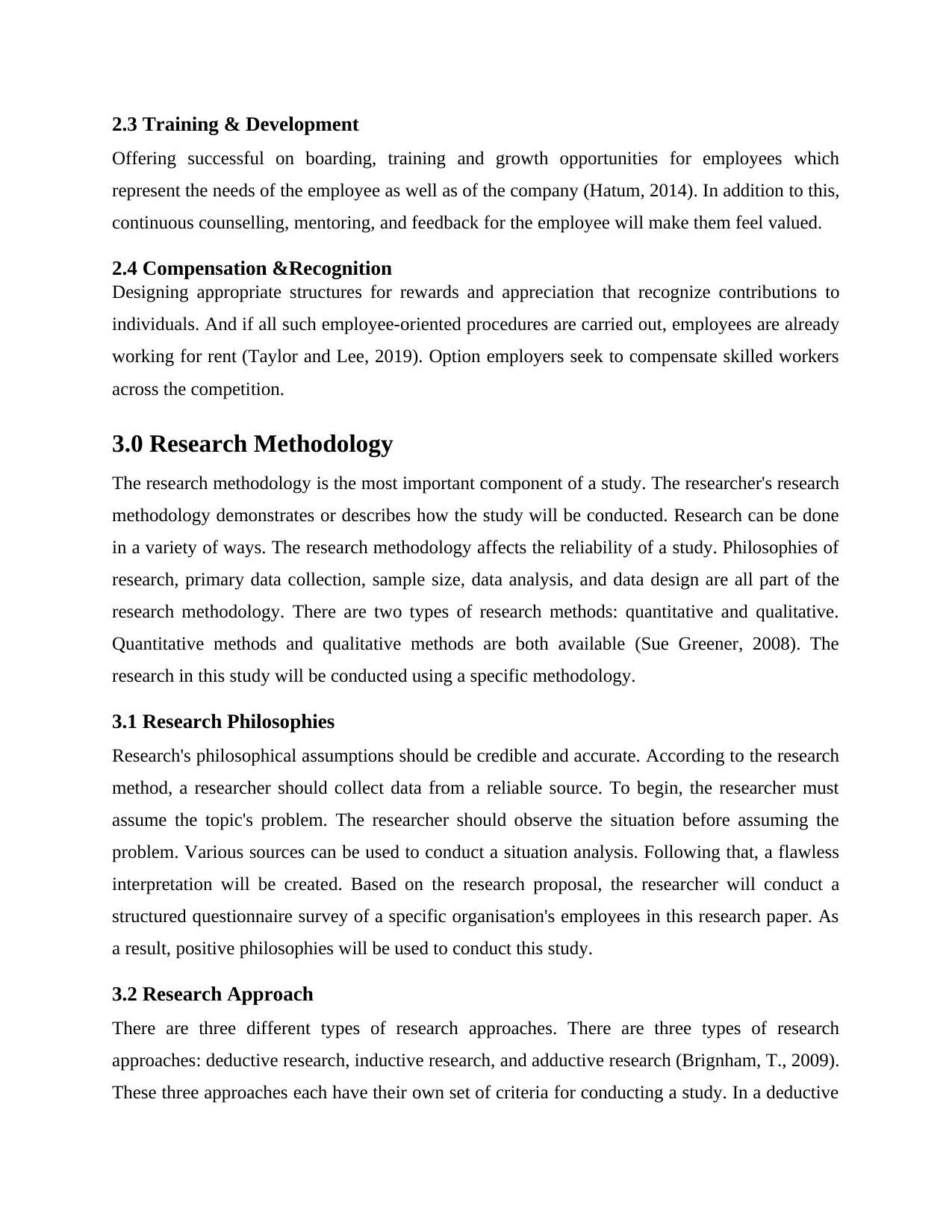
2.3 Training & Development
Offering successful on boarding, training and growth opportunities for employees which
represent the needs of the employee as well as of the company (Hatum, 2014). In addition to this,
continuous counselling, mentoring, and feedback for the employee will make them feel valued.
2.4 Compensation &Recognition
Designing appropriate structures for rewards and appreciation that recognize contributions to
individuals. And if all such employee-oriented procedures are carried out, employees are already
working for rent (Taylor and Lee, 2019). Option employers seek to compensate skilled workers
across the competition.
3.0 Research Methodology
The research methodology is the most important component of a study. The researcher's research
methodology demonstrates or describes how the study will be conducted. Research can be done
in a variety of ways. The research methodology affects the reliability of a study. Philosophies of
research, primary data collection, sample size, data analysis, and data design are all part of the
research methodology. There are two types of research methods: quantitative and qualitative.
Quantitative methods and qualitative methods are both available (Sue Greener, 2008). The
research in this study will be conducted using a specific methodology.
3.1 Research Philosophies
Research's philosophical assumptions should be credible and accurate. According to the research
method, a researcher should collect data from a reliable source. To begin, the researcher must
assume the topic's problem. The researcher should observe the situation before assuming the
problem. Various sources can be used to conduct a situation analysis. Following that, a flawless
interpretation will be created. Based on the research proposal, the researcher will conduct a
structured questionnaire survey of a specific organisation's employees in this research paper. As
a result, positive philosophies will be used to conduct this study.
3.2 Research Approach
There are three different types of research approaches. There are three types of research
approaches: deductive research, inductive research, and adductive research (Brignham, T., 2009).
These three approaches each have their own set of criteria for conducting a study. In a deductive
Offering successful on boarding, training and growth opportunities for employees which
represent the needs of the employee as well as of the company (Hatum, 2014). In addition to this,
continuous counselling, mentoring, and feedback for the employee will make them feel valued.
2.4 Compensation &Recognition
Designing appropriate structures for rewards and appreciation that recognize contributions to
individuals. And if all such employee-oriented procedures are carried out, employees are already
working for rent (Taylor and Lee, 2019). Option employers seek to compensate skilled workers
across the competition.
3.0 Research Methodology
The research methodology is the most important component of a study. The researcher's research
methodology demonstrates or describes how the study will be conducted. Research can be done
in a variety of ways. The research methodology affects the reliability of a study. Philosophies of
research, primary data collection, sample size, data analysis, and data design are all part of the
research methodology. There are two types of research methods: quantitative and qualitative.
Quantitative methods and qualitative methods are both available (Sue Greener, 2008). The
research in this study will be conducted using a specific methodology.
3.1 Research Philosophies
Research's philosophical assumptions should be credible and accurate. According to the research
method, a researcher should collect data from a reliable source. To begin, the researcher must
assume the topic's problem. The researcher should observe the situation before assuming the
problem. Various sources can be used to conduct a situation analysis. Following that, a flawless
interpretation will be created. Based on the research proposal, the researcher will conduct a
structured questionnaire survey of a specific organisation's employees in this research paper. As
a result, positive philosophies will be used to conduct this study.
3.2 Research Approach
There are three different types of research approaches. There are three types of research
approaches: deductive research, inductive research, and adductive research (Brignham, T., 2009).
These three approaches each have their own set of criteria for conducting a study. In a deductive
Paraphrase This Document
Need a fresh take? Get an instant paraphrase of this document with our AI Paraphraser
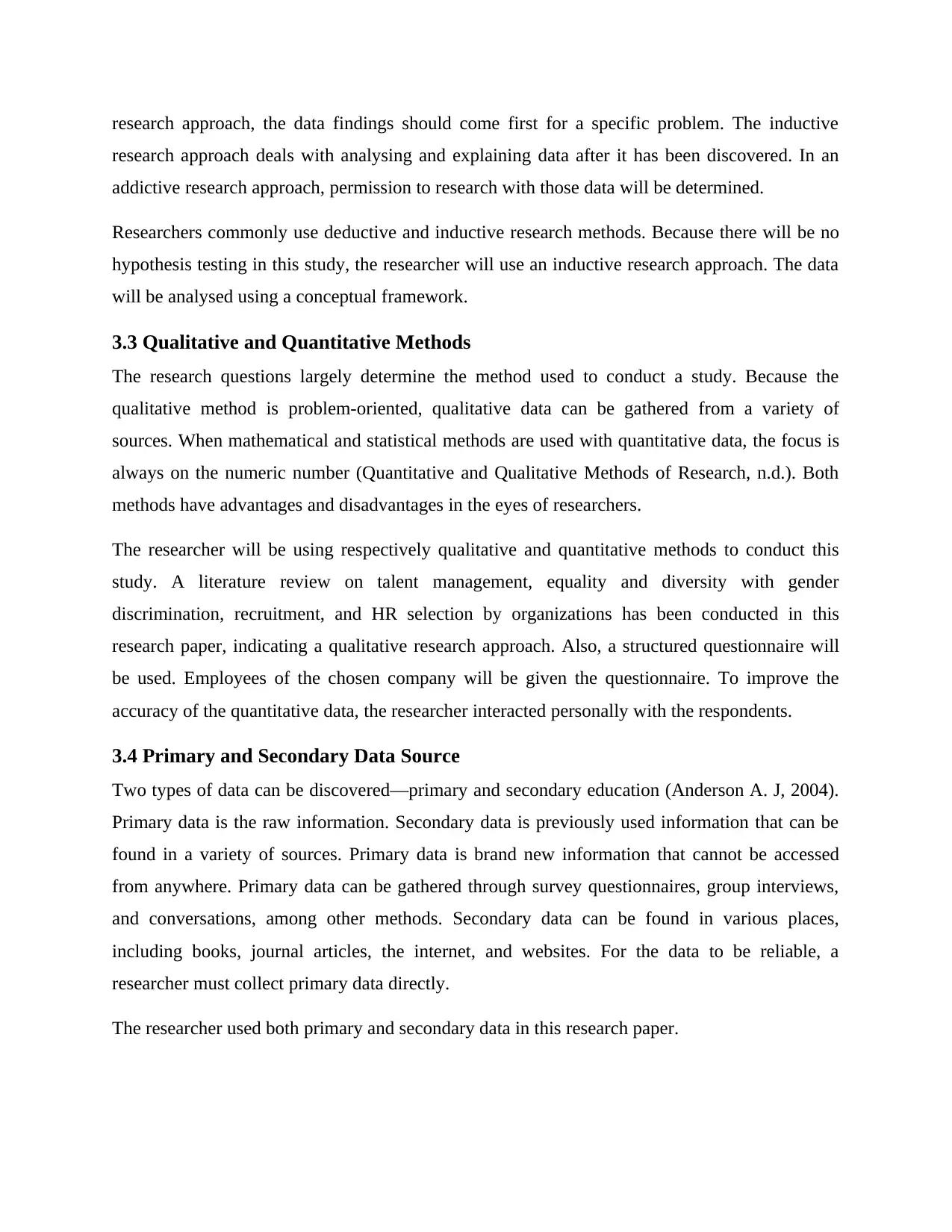
research approach, the data findings should come first for a specific problem. The inductive
research approach deals with analysing and explaining data after it has been discovered. In an
addictive research approach, permission to research with those data will be determined.
Researchers commonly use deductive and inductive research methods. Because there will be no
hypothesis testing in this study, the researcher will use an inductive research approach. The data
will be analysed using a conceptual framework.
3.3 Qualitative and Quantitative Methods
The research questions largely determine the method used to conduct a study. Because the
qualitative method is problem-oriented, qualitative data can be gathered from a variety of
sources. When mathematical and statistical methods are used with quantitative data, the focus is
always on the numeric number (Quantitative and Qualitative Methods of Research, n.d.). Both
methods have advantages and disadvantages in the eyes of researchers.
The researcher will be using respectively qualitative and quantitative methods to conduct this
study. A literature review on talent management, equality and diversity with gender
discrimination, recruitment, and HR selection by organizations has been conducted in this
research paper, indicating a qualitative research approach. Also, a structured questionnaire will
be used. Employees of the chosen company will be given the questionnaire. To improve the
accuracy of the quantitative data, the researcher interacted personally with the respondents.
3.4 Primary and Secondary Data Source
Two types of data can be discovered—primary and secondary education (Anderson A. J, 2004).
Primary data is the raw information. Secondary data is previously used information that can be
found in a variety of sources. Primary data is brand new information that cannot be accessed
from anywhere. Primary data can be gathered through survey questionnaires, group interviews,
and conversations, among other methods. Secondary data can be found in various places,
including books, journal articles, the internet, and websites. For the data to be reliable, a
researcher must collect primary data directly.
The researcher used both primary and secondary data in this research paper.
research approach deals with analysing and explaining data after it has been discovered. In an
addictive research approach, permission to research with those data will be determined.
Researchers commonly use deductive and inductive research methods. Because there will be no
hypothesis testing in this study, the researcher will use an inductive research approach. The data
will be analysed using a conceptual framework.
3.3 Qualitative and Quantitative Methods
The research questions largely determine the method used to conduct a study. Because the
qualitative method is problem-oriented, qualitative data can be gathered from a variety of
sources. When mathematical and statistical methods are used with quantitative data, the focus is
always on the numeric number (Quantitative and Qualitative Methods of Research, n.d.). Both
methods have advantages and disadvantages in the eyes of researchers.
The researcher will be using respectively qualitative and quantitative methods to conduct this
study. A literature review on talent management, equality and diversity with gender
discrimination, recruitment, and HR selection by organizations has been conducted in this
research paper, indicating a qualitative research approach. Also, a structured questionnaire will
be used. Employees of the chosen company will be given the questionnaire. To improve the
accuracy of the quantitative data, the researcher interacted personally with the respondents.
3.4 Primary and Secondary Data Source
Two types of data can be discovered—primary and secondary education (Anderson A. J, 2004).
Primary data is the raw information. Secondary data is previously used information that can be
found in a variety of sources. Primary data is brand new information that cannot be accessed
from anywhere. Primary data can be gathered through survey questionnaires, group interviews,
and conversations, among other methods. Secondary data can be found in various places,
including books, journal articles, the internet, and websites. For the data to be reliable, a
researcher must collect primary data directly.
The researcher used both primary and secondary data in this research paper.
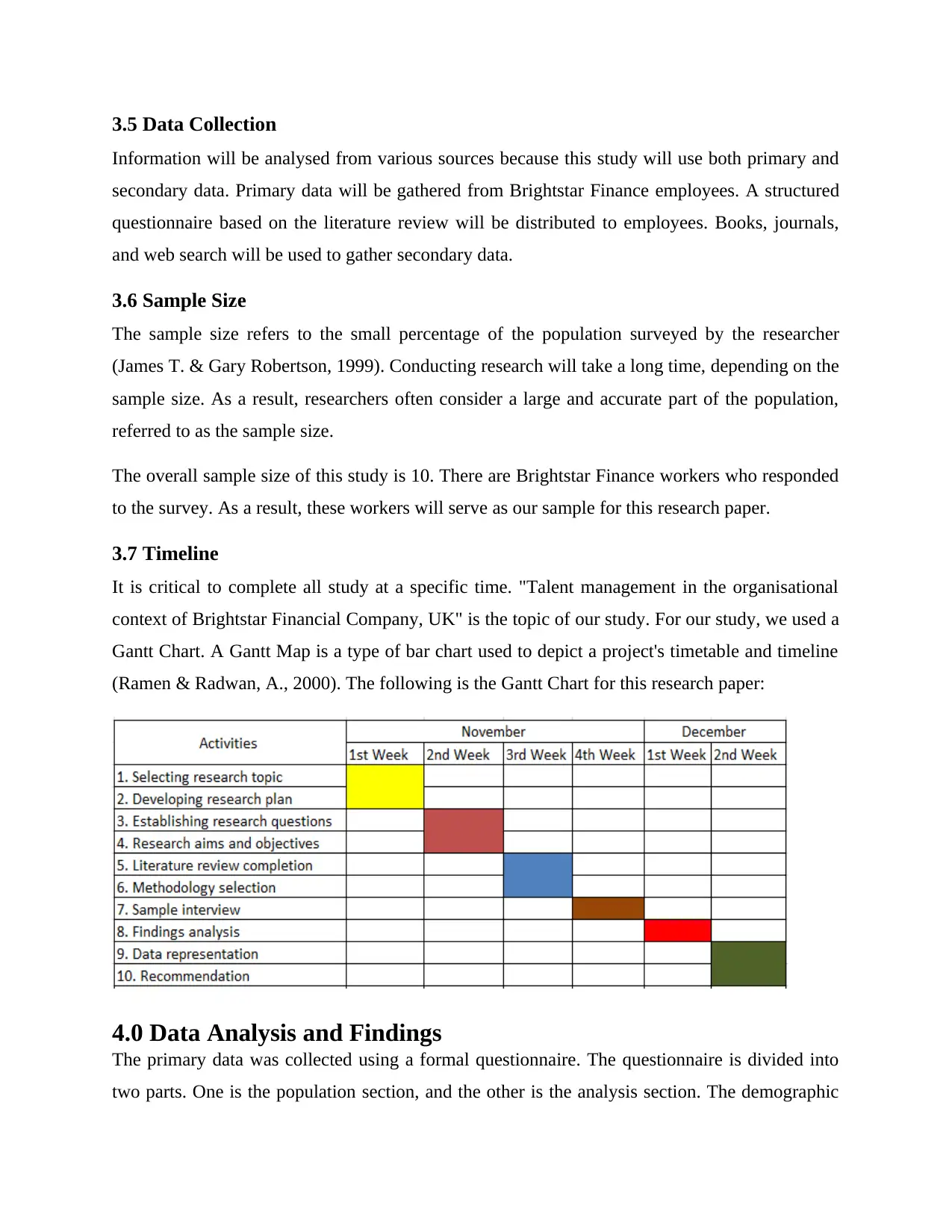
3.5 Data Collection
Information will be analysed from various sources because this study will use both primary and
secondary data. Primary data will be gathered from Brightstar Finance employees. A structured
questionnaire based on the literature review will be distributed to employees. Books, journals,
and web search will be used to gather secondary data.
3.6 Sample Size
The sample size refers to the small percentage of the population surveyed by the researcher
(James T. & Gary Robertson, 1999). Conducting research will take a long time, depending on the
sample size. As a result, researchers often consider a large and accurate part of the population,
referred to as the sample size.
The overall sample size of this study is 10. There are Brightstar Finance workers who responded
to the survey. As a result, these workers will serve as our sample for this research paper.
3.7 Timeline
It is critical to complete all study at a specific time. "Talent management in the organisational
context of Brightstar Financial Company, UK" is the topic of our study. For our study, we used a
Gantt Chart. A Gantt Map is a type of bar chart used to depict a project's timetable and timeline
(Ramen & Radwan, A., 2000). The following is the Gantt Chart for this research paper:
4.0 Data Analysis and Findings
The primary data was collected using a formal questionnaire. The questionnaire is divided into
two parts. One is the population section, and the other is the analysis section. The demographic
Information will be analysed from various sources because this study will use both primary and
secondary data. Primary data will be gathered from Brightstar Finance employees. A structured
questionnaire based on the literature review will be distributed to employees. Books, journals,
and web search will be used to gather secondary data.
3.6 Sample Size
The sample size refers to the small percentage of the population surveyed by the researcher
(James T. & Gary Robertson, 1999). Conducting research will take a long time, depending on the
sample size. As a result, researchers often consider a large and accurate part of the population,
referred to as the sample size.
The overall sample size of this study is 10. There are Brightstar Finance workers who responded
to the survey. As a result, these workers will serve as our sample for this research paper.
3.7 Timeline
It is critical to complete all study at a specific time. "Talent management in the organisational
context of Brightstar Financial Company, UK" is the topic of our study. For our study, we used a
Gantt Chart. A Gantt Map is a type of bar chart used to depict a project's timetable and timeline
(Ramen & Radwan, A., 2000). The following is the Gantt Chart for this research paper:
4.0 Data Analysis and Findings
The primary data was collected using a formal questionnaire. The questionnaire is divided into
two parts. One is the population section, and the other is the analysis section. The demographic
⊘ This is a preview!⊘
Do you want full access?
Subscribe today to unlock all pages.

Trusted by 1+ million students worldwide
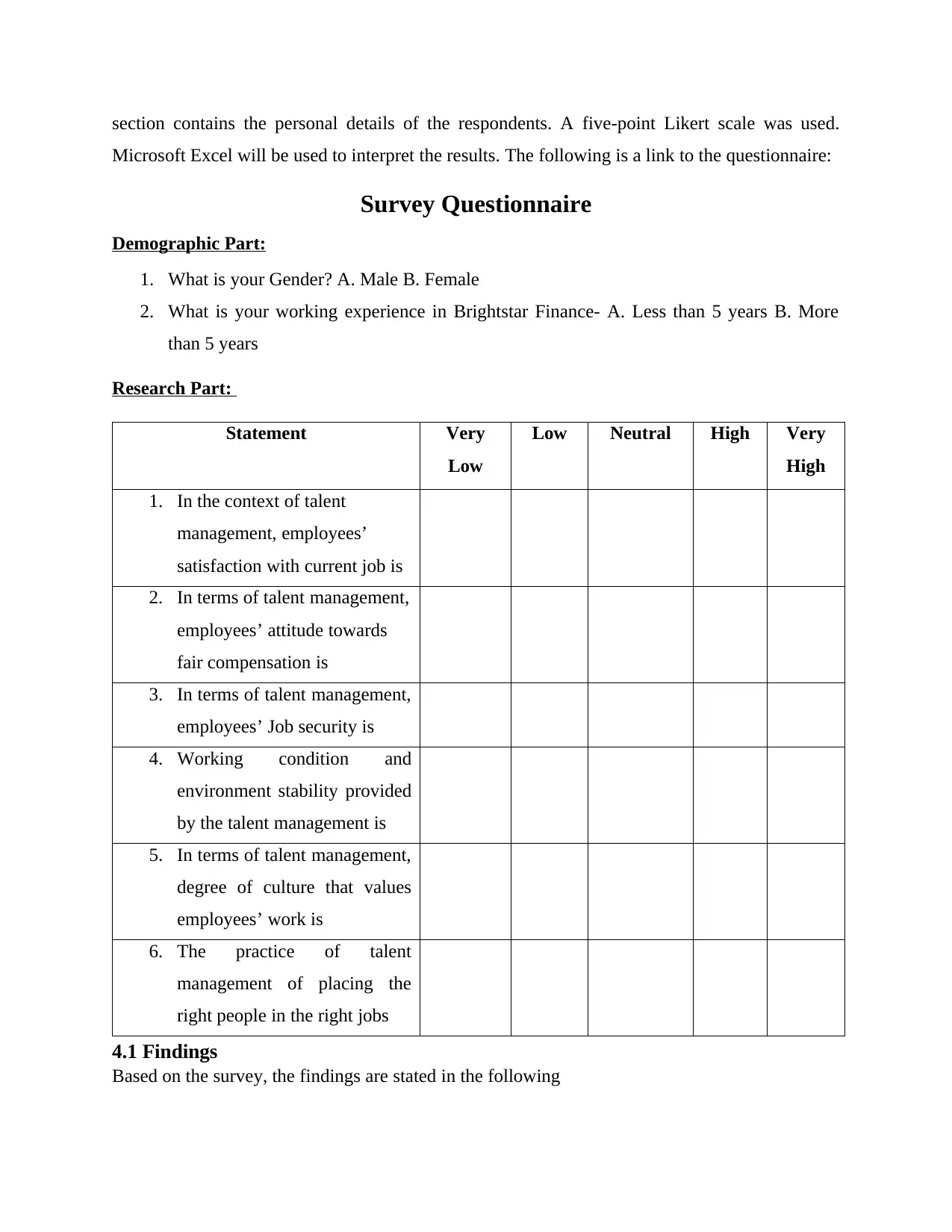
section contains the personal details of the respondents. A five-point Likert scale was used.
Microsoft Excel will be used to interpret the results. The following is a link to the questionnaire:
Survey Questionnaire
Demographic Part:
1. What is your Gender? A. Male B. Female
2. What is your working experience in Brightstar Finance- A. Less than 5 years B. More
than 5 years
Research Part:
Statement Very
Low
Low Neutral High Very
High
1. In the context of talent
management, employees’
satisfaction with current job is
2. In terms of talent management,
employees’ attitude towards
fair compensation is
3. In terms of talent management,
employees’ Job security is
4. Working condition and
environment stability provided
by the talent management is
5. In terms of talent management,
degree of culture that values
employees’ work is
6. The practice of talent
management of placing the
right people in the right jobs
4.1 Findings
Based on the survey, the findings are stated in the following
Microsoft Excel will be used to interpret the results. The following is a link to the questionnaire:
Survey Questionnaire
Demographic Part:
1. What is your Gender? A. Male B. Female
2. What is your working experience in Brightstar Finance- A. Less than 5 years B. More
than 5 years
Research Part:
Statement Very
Low
Low Neutral High Very
High
1. In the context of talent
management, employees’
satisfaction with current job is
2. In terms of talent management,
employees’ attitude towards
fair compensation is
3. In terms of talent management,
employees’ Job security is
4. Working condition and
environment stability provided
by the talent management is
5. In terms of talent management,
degree of culture that values
employees’ work is
6. The practice of talent
management of placing the
right people in the right jobs
4.1 Findings
Based on the survey, the findings are stated in the following
Paraphrase This Document
Need a fresh take? Get an instant paraphrase of this document with our AI Paraphraser
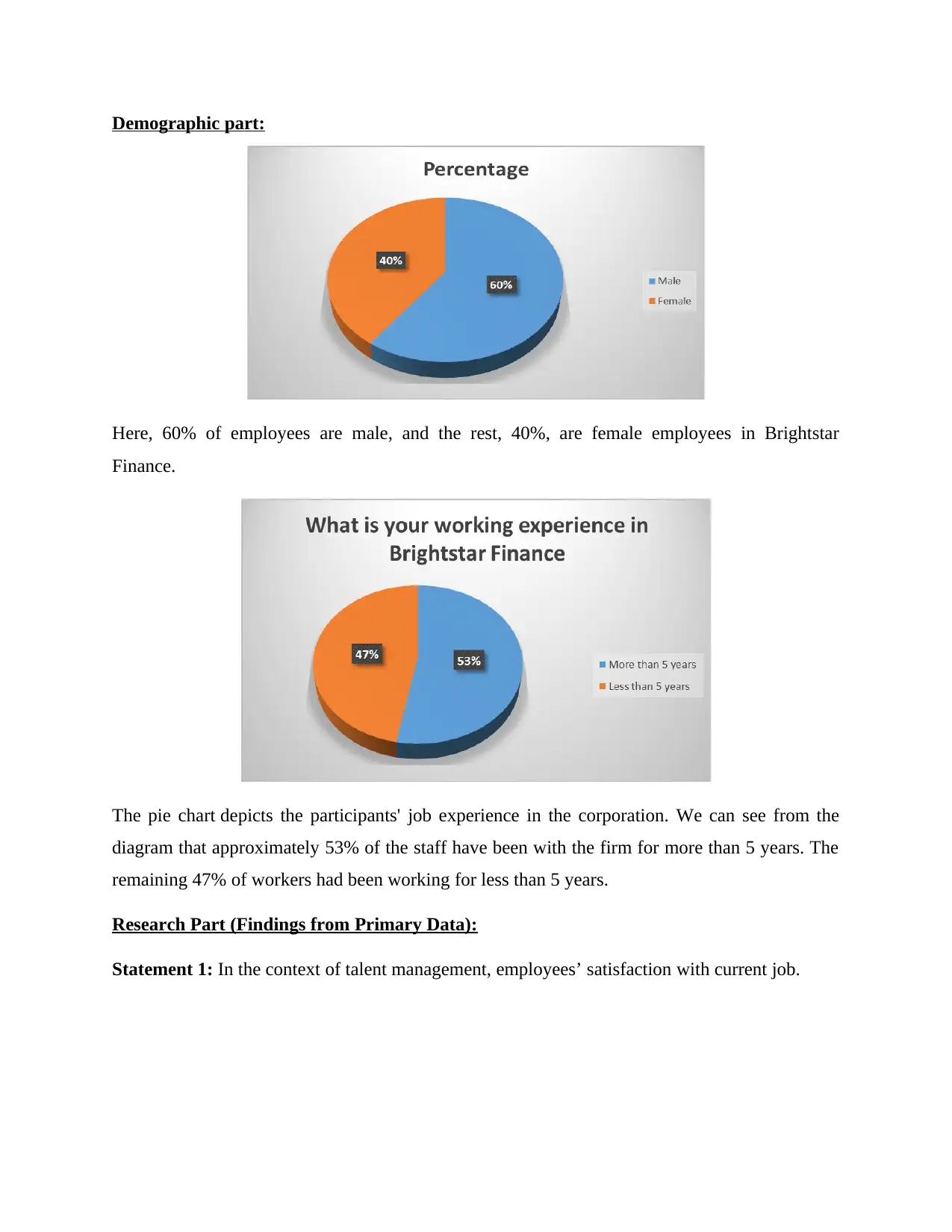
Demographic part:
Here, 60% of employees are male, and the rest, 40%, are female employees in Brightstar
Finance.
The pie chart depicts the participants' job experience in the corporation. We can see from the
diagram that approximately 53% of the staff have been with the firm for more than 5 years. The
remaining 47% of workers had been working for less than 5 years.
Research Part (Findings from Primary Data):
Statement 1: In the context of talent management, employees’ satisfaction with current job.
Here, 60% of employees are male, and the rest, 40%, are female employees in Brightstar
Finance.
The pie chart depicts the participants' job experience in the corporation. We can see from the
diagram that approximately 53% of the staff have been with the firm for more than 5 years. The
remaining 47% of workers had been working for less than 5 years.
Research Part (Findings from Primary Data):
Statement 1: In the context of talent management, employees’ satisfaction with current job.
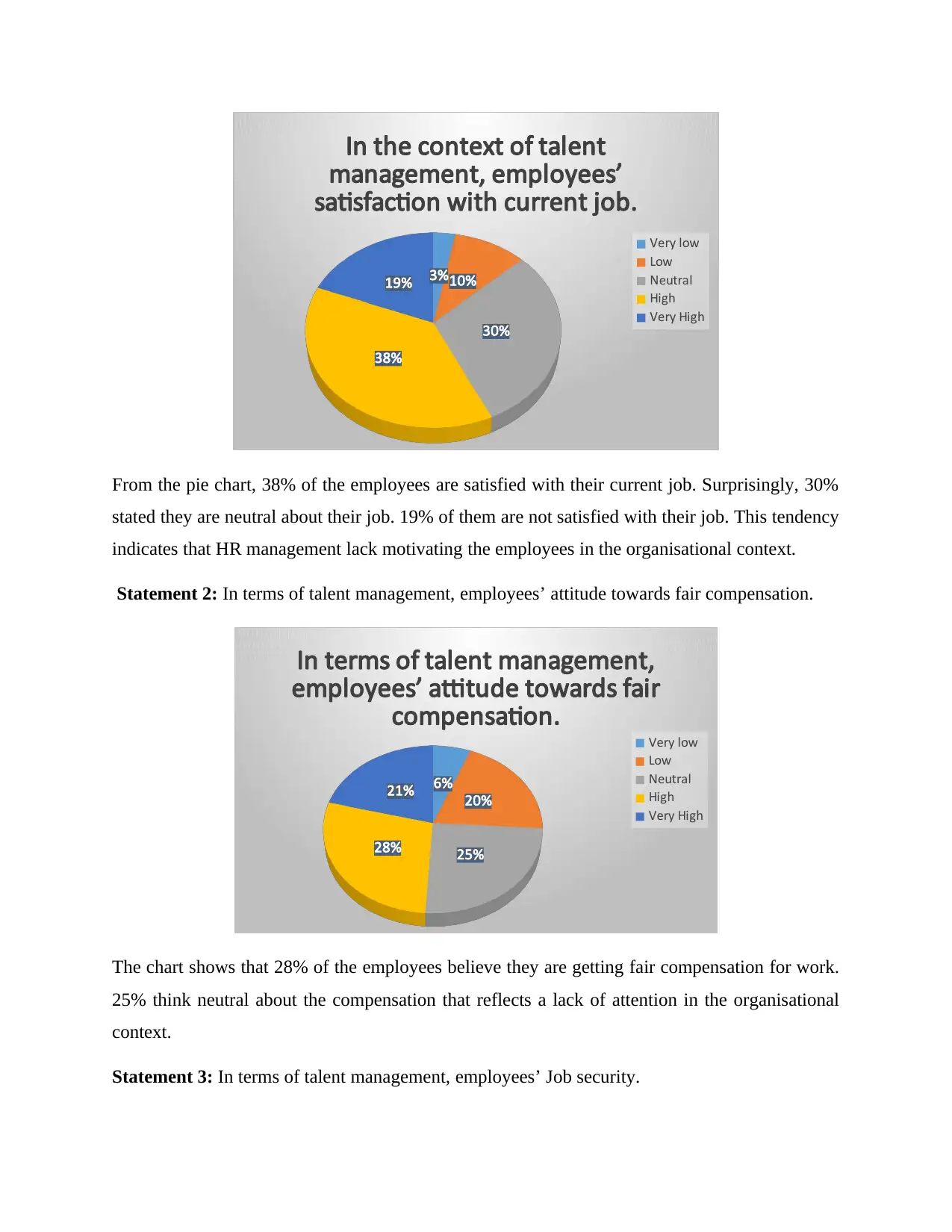
3%10%
30%
38%
19%
In the context of talent
management, employees’
satisfaction with current job.
Very low
Low
Neutral
High
Very High
From the pie chart, 38% of the employees are satisfied with their current job. Surprisingly, 30%
stated they are neutral about their job. 19% of them are not satisfied with their job. This tendency
indicates that HR management lack motivating the employees in the organisational context.
Statement 2: In terms of talent management, employees’ attitude towards fair compensation.
6%
20%
25%28%
21%
In terms of talent management,
employees’ attitude towards fair
compensation. Very low
Low
Neutral
High
Very High
The chart shows that 28% of the employees believe they are getting fair compensation for work.
25% think neutral about the compensation that reflects a lack of attention in the organisational
context.
Statement 3: In terms of talent management, employees’ Job security.
30%
38%
19%
In the context of talent
management, employees’
satisfaction with current job.
Very low
Low
Neutral
High
Very High
From the pie chart, 38% of the employees are satisfied with their current job. Surprisingly, 30%
stated they are neutral about their job. 19% of them are not satisfied with their job. This tendency
indicates that HR management lack motivating the employees in the organisational context.
Statement 2: In terms of talent management, employees’ attitude towards fair compensation.
6%
20%
25%28%
21%
In terms of talent management,
employees’ attitude towards fair
compensation. Very low
Low
Neutral
High
Very High
The chart shows that 28% of the employees believe they are getting fair compensation for work.
25% think neutral about the compensation that reflects a lack of attention in the organisational
context.
Statement 3: In terms of talent management, employees’ Job security.
⊘ This is a preview!⊘
Do you want full access?
Subscribe today to unlock all pages.

Trusted by 1+ million students worldwide
1 out of 25
Related Documents
Your All-in-One AI-Powered Toolkit for Academic Success.
+13062052269
info@desklib.com
Available 24*7 on WhatsApp / Email
![[object Object]](/_next/static/media/star-bottom.7253800d.svg)
Unlock your academic potential
Copyright © 2020–2025 A2Z Services. All Rights Reserved. Developed and managed by ZUCOL.





